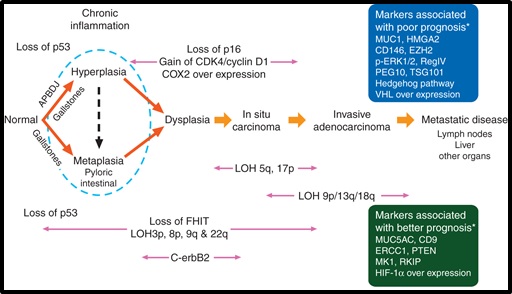
A genetic model for gallbladder carcinogenesis
Clinical collaborator: Dr. George Barreto (Medanta)The incidence of gallbladder cancer in developed nations is as low as 1–2.5 per 100,000, its worldwide incidence rates among different geographic areas and ethnicities vary widely reaching extremely high rates in South American Indians (15.5 per 100,000 in women), Eastern Europe (14/100,000 in Poland), northern India (as high as 21.5/100,000 for women from Delhi), and south Pakistan (11.3/100,000). The apparent uncommonness of gallbladder cancer in the developed world has contributed to the generally poor understanding of the disease. The development of new and effective treatment therefore has been and continues to be a major public health imperative. Developing a deeper understanding of the genetic transformations involved in the development of gallbladder cancer could help in the planning of epidemiological studies aimed at identifying screening markers especially in regions of a high incidence of gallbladder cancer.
Here we propose a hypothetical model – ‘A Gallbladder Carcinogenesis and Dissemination Model’, wherein we discuss in depth dysplasia as a premalignant lesion that could potentially develop into carcinoma in situ and invasive gallbladder adenocarcinoma. The model proposed compiles and extends the current understanding in the field., akin to the Fearon-Vogelstein model for colorectal tumorigenesis.

[The ‘Gallbladder carcinogenesis and dissemination model’. The proposed model takes into consideration each and every pathological change occurring in the gallbladder epithelium progressing sequentially from normal epithelial mucosa to the development of cancer via the two most common pathways, namely metaplasia/hyperplasia as well as dysplasia, and beyond the localized disease in the gallbladder to even include the spread of the cancer to regional and distant organs. ]
[ANNALS OF ONCOLOGY]